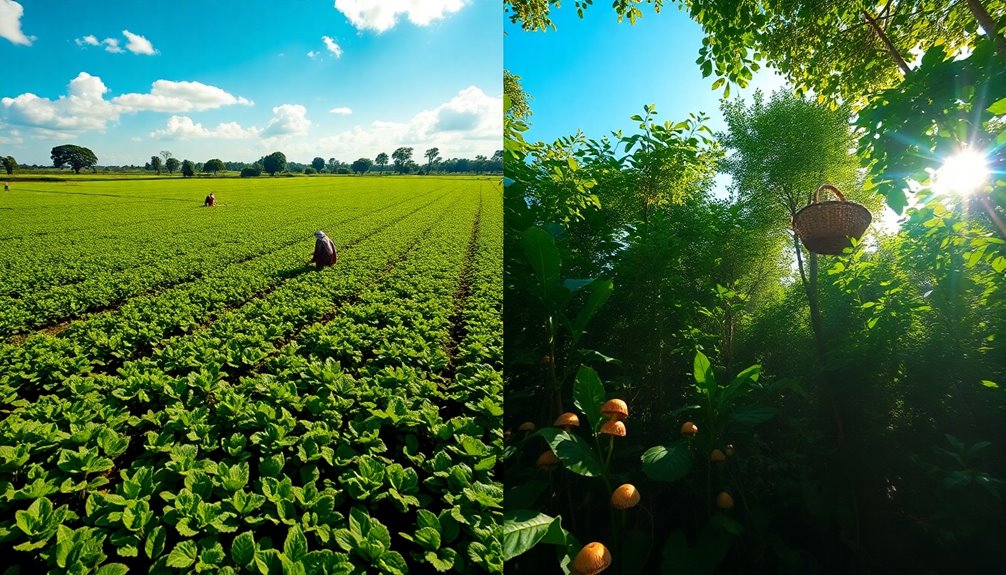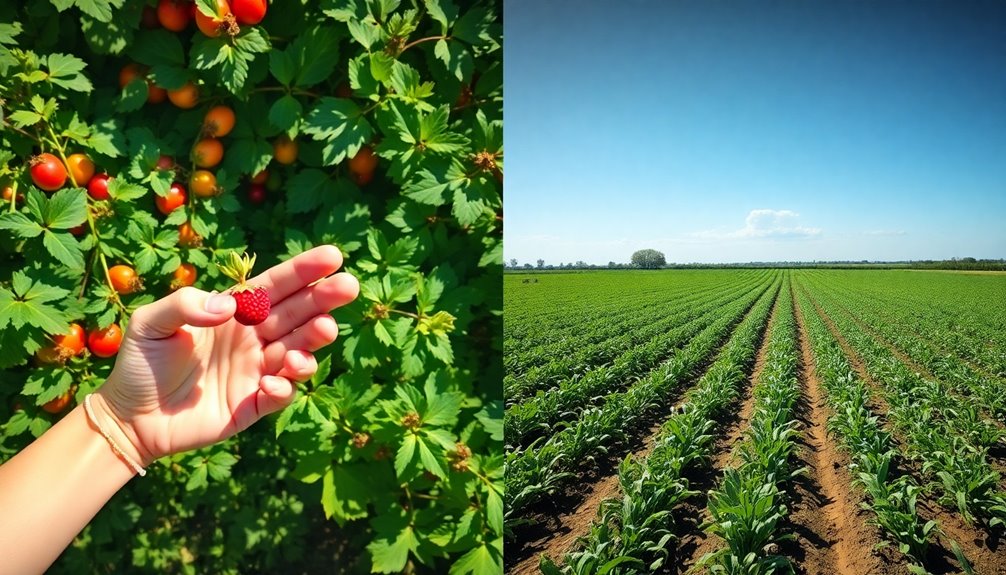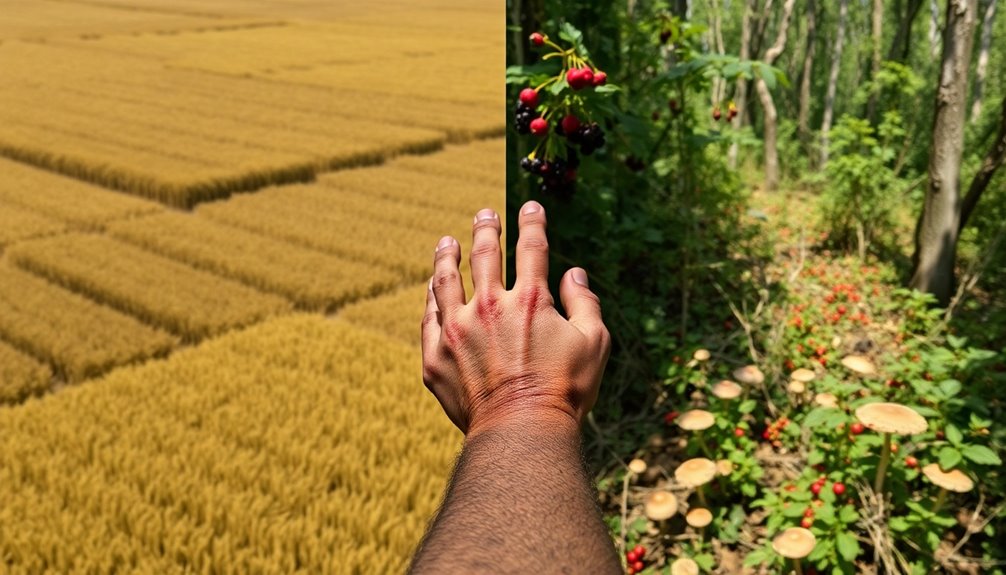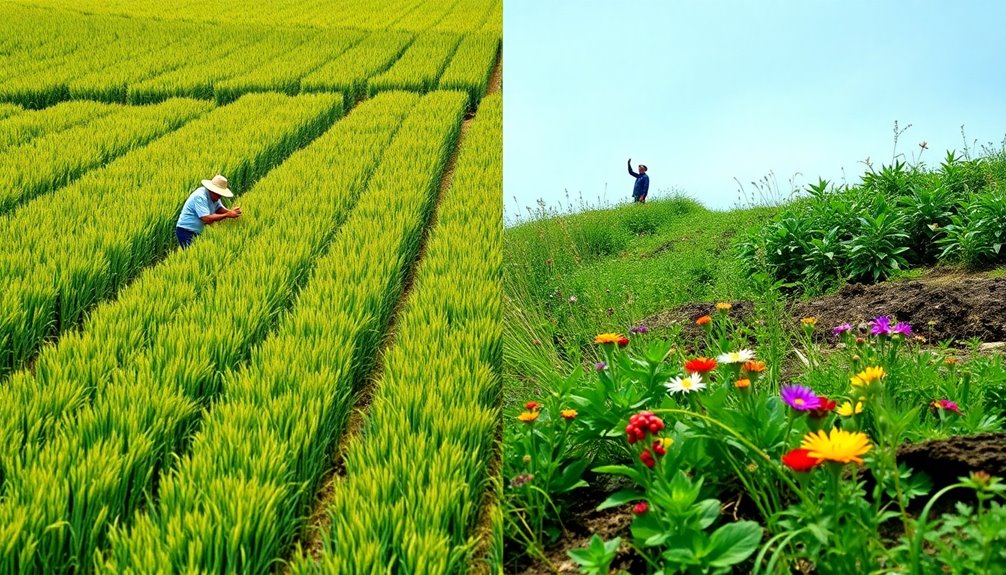The shift from foraging to farming was a mixed bag of improvements and setbacks. On one hand, farming boosted food production and allowed for larger, more complex societies, paving the way for technological advancements. However, it also led to health decline due to poorer diets and the rise of chronic diseases. In addition, farming societies often faced increased social inequality, contrasting sharply with the more egalitarian nature of hunter-gatherer communities. While this change marked notable progress, it introduced vulnerable food systems and environmental challenges. You might discover fascinating insights into how these ancient choices shaped today's world.
Key Takeaways
- The transition to farming allowed for population growth and the establishment of permanent settlements, enhancing social complexity and technological advancements.
- Farming provided a more stable food supply but led to nutritional limitations and increased health issues compared to the diverse diets of foragers.
- Agricultural practices resulted in social hierarchies and increased inequality, contrasting with the egalitarian structures of hunter-gatherer societies.
- While farming created leisure time constraints, it also fostered new cultural practices and community dynamics, although these diminished compared to foraging lifestyles.
- Environmental consequences of farming, such as soil degradation and reliance on monocultures, raised vulnerabilities in food security compared to sustainable foraging methods.
Historical Context of Foraging and Farming

The shift from foraging to farming, often referred to as the Neolithic Revolution, reshaped human history around 11,000 years ago. This transformation marked a significant change from the nomadic hunter-gatherer societies that relied on wild food sources to settled agricultural societies that domesticated plants and animals.
Early agricultural practices began gradually, with evidence showing that people started exploiting wild grains about 14,500 years ago. As you explore this evolution, consider how the development of farming allowed for more stable and predictable food supplies, which in turn supported the growth of complex communities.
Sites like Catal Huyuk in modern Turkey illustrate this shift; they housed thousands of residents and featured interconnected structures, showcasing the social complexity that agricultural societies developed.
Despite this, it's crucial to recognize that hunter-gatherer societies weren't merely transient. Research in the Fertile Crescent indicates they often congregated for extended periods, fostering social connections and cooperation.
Health Outcomes: Foraging vs. Farming

When comparing health outcomes between foraging and farming, it's clear that hunter-gatherers often enjoyed better overall health. Foraging societies typically thrived on a diverse diet that included a variety of wild plants and animals, which led to lower rates of chronic diseases.
Here are three key points highlighting this difference:
- Nutritional Diversity: Hunter-gatherers had access to a wide range of nutrients, while agricultural practices often resulted in deficiencies due to reliance on a limited number of crops.
- Disease Exposure: The close quarters of early farmers with domesticated animals increased their risk of diseases like malaria and smallpox, illnesses that were much less common in foraging communities.
- Skeletal Health: Research shows that skeletons from foraging societies exhibit no signs of modern diseases, whereas early farmers faced malnutrition and skeletal issues linked to their sedentary lifestyles.
These factors illustrate that the health outcomes of foraging provided significant advantages over those of farming, which introduced long-term consequences that affected the well-being of agriculturalists.
Social Structures and Inequality

When you look at hunter-gatherer societies, you'll find a striking level of equality with minimal hierarchies.
In contrast, as communities shifted to agriculture, social classes emerged, creating wealth disparities and increased gender inequality.
This change laid the groundwork for the social structures we still see today, where class distinctions continue to shape our lives.
Hunter-Gatherer Equality
Examining hunter-gatherer societies reveals a striking contrast to later agricultural communities, showcasing their egalitarian structures and minimal social hierarchies. In these communities, you'd notice a more equal distribution of resources, allowing for a sense of shared responsibility and cooperation.
Here are three key aspects of their social organization:
- Resource Sharing: Hunter-gatherers relied on communal efforts for food gathering, reducing individual wealth accumulation and promoting equality.
- Flexible Gender Roles: Both men and women actively participated in gathering and hunting, fostering a balanced social dynamic and diminishing rigid gender roles.
- Absence of Poverty: Unlike agricultural societies, which introduced social classes and poverty, hunter-gatherers had few possessions and weren't defined by material wealth or lack thereof.
In this way, hunter-gatherer societies maintained egalitarian structures that minimized social stratification.
Their model starkly contrasts with the emergence of agricultural communities, where the accumulation of surplus food led to pronounced inequalities and exploitation.
Ultimately, this shift set a precedent for the social disparities that still exist today.
Agricultural Class Distinction
In agricultural societies, a noticeable shift occurs as social class distinctions emerge, fundamentally altering the way communities operate. The change from foraging to farming leads to social stratification based on control of food surplus. Those who manage to accumulate wealth through agriculture often gain power, creating pronounced class divisions. Kevin Reilly highlights how this shift also spawns poverty as a recognized social status, something less prevalent in hunter-gatherer groups. Furthermore, the need for financial considerations in managing agricultural resources reflects the complexities introduced by this newfound wealth.
Moreover, gender inequality intensifies in these agrarian settings. Men typically take on superior roles, while women's contributions are often undervalued, contrasting sharply with the more egalitarian structures of hunter-gatherer societies where both genders actively participate in securing sustenance.
As agriculturalists settle and develop complex social hierarchies, competition for resources grows. Archaeological evidence shows that this sedentary lifestyle fosters exploitation and inequality, resonating through history, as demonstrated by events like the Great Leap Forward. Additionally, the emotional instability observed in individuals with Borderline Personality Disorder can reflect the intense social dynamics present in these class-structured societies.
Today, the inequalities established in early agricultural communities echo in modern societies, where issues of wealth distribution and social stratification continue to challenge our understanding of equality. Consequently, the shift to agriculture, while revolutionary, laid the groundwork for enduring disparities.
Leisure Time in Hunter-Gatherer Societies

Although modern perspectives often glorify the hustle and bustle of contemporary life, hunter-gatherer societies enjoyed a remarkable balance between work and leisure. Typically, they spent only 12-19 hours per week obtaining food, leaving them with ample leisure time. This abundance of free time fostered community well-being, allowing individuals to engage in cultural and technological pursuits beyond mere survival.
Here are three ways hunter-gatherers utilized their leisure time:
- Cultural Activities: They shared stories, music, and art, enhancing social bonds and passing down knowledge through generations.
- Skill Development: Hunter-gatherers honed their skills in tool-making and foraging, ensuring a well-rounded community adept at adapting to changing environments.
- Social Interactions: Their nomadic lifestyle encouraged flexibility and mobility, enabling gatherings and fostering strong communal ties, which agricultural societies often lacked.
In contrast, agricultural societies required longer working hours for food production, leading to decreased leisure time and increased stress.
Consequently, the hunter-gatherer way of life exemplifies how a balance of work and leisure can greatly enhance community well-being, proving that sometimes less truly is more.
Technological Developments From Agriculture

When agriculture took off, it spurred a wave of technological innovations that changed the way people lived.
You'd see the introduction of tools like scythes and irrigation systems, which made farming more efficient and reliable.
This shift also led to permanent settlements, allowing for specialized labor and further advancements in technology.
Agricultural Innovations and Tools
Agricultural innovations have revolutionized how societies produce food, marking a notable departure from foraging. With the shift to agriculture around 11,000 years ago, new tools emerged that greatly boosted farming efficiency. You'd see the change from basic stone and bone implements to advanced metal tools like scythes and hoes, enabling larger-scale farming. Dual-flush toilets highlight how modern innovations can also lead to better resource management.
Here are three key innovations that transformed agriculture:
- Irrigation Systems: These allowed for controlled water supply, expanding arable land and supporting larger populations, similar to how foraging practices adapt to different environments. Additionally, these systems often utilized natural signs to optimize water usage based on seasonal changes. Moreover, the implementation of geothermal heat pumps in irrigation can enhance efficiency by utilizing the Earth's stable temperature for energy needs.
- Plowing Techniques: By using plows, farmers could cultivate soil more deeply and efficiently, increasing crop yields.
- Domestication of Plants and Animals: This not only changed food production methods but also led to advancements in food storage and preservation.
As agriculture developed, the need for more complex tools and techniques became apparent, which played a vital role in the establishment of permanent settlements. The introduction of heat pumps in agricultural practices has also contributed to enhanced energy efficiency and sustainability in food production.
The specialization of labor flourished, resulting in diverse professions—like farmers, artisans, and scribes—marking a shift towards complex social structures. These innovations laid the foundational framework for modern agriculture, shaping how we produce food today.
Impact on Settlements Growth
The advancements in farming technology directly influenced the growth of settlements, transforming how communities formed and interacted. Around 11,000 years ago, the shift to agriculture marked a pivotal moment, allowing for the establishment of permanent dwellings. These early settlements, such as those in Catal Huyuk, supported populations of 5,000 to 8,000 people, fostering social complexity and cooperation among residents. Additionally, the emergence of leadership skills within these communities played a crucial role in organizing efforts and maintaining order.
With improved agricultural practices came technological innovations like irrigation systems and metal tools, enhancing farming efficiency and resource management. This led to intensified resource extraction, enabling societies to support larger populations and specialized labor roles, as seen in ancient Egypt. The cultivation of crops also encouraged the development of wellness retreats that promoted health and community bonding among the growing populations. Furthermore, setting up a Montessori-inspired nursery can provide children with an early introduction to responsibility and independence, skills that are essential in a thriving community. The introduction of business financing options further supported agricultural expansion and settlement growth.
As settlements grew, the establishment of fortified cities illustrated a newfound sense of stability and security, clearly showcasing the advantages of sedentary agricultural life over nomadic foraging. Additionally, the development of wellness programs in these communities highlighted the increasing importance of health and well-being as agriculture flourished.
The growth of these civilizations not only increased population density but also catalyzed interactions among diverse communities, ultimately shaping the course of human history. Agriculture didn't just feed people; it built the foundations of society, setting the stage for the complex civilizations we recognize today.
Environmental Impact of Farming Practices

Farming practices have considerably altered ecosystems, often resulting in detrimental effects on the environment. As you explore the implications of these practices, you'll notice significant consequences that stem from the shift from foraging to farming.
Here are three critical impacts to reflect on:
- Soil Degradation: Intensive farming methods, such as monoculture, lead to decreased soil fertility and increased soil erosion. Over time, this can diminish crop yields and require more fertilizers, perpetuating the cycle of degradation.
- Loss of Biodiversity: The clearing of land for crops and livestock reduces habitats for many species. This loss of biodiversity disrupts ecosystems, making them more vulnerable to pests and diseases, ultimately affecting agricultural productivity.
- Overexploitation of Resources: The demand for consistent yields results in the overexploitation of local resources. This not only depletes wild plant and animal populations but also contributes to habitat destruction, further destabilizing ecosystems. Moreover, the shift to farming has often led to increased reliance on renewable wood fuel, which has implications for both sustainability and resource management.
Nutritional Diversity in Traditional Diets

When you look at traditional diets, the benefits of a hunter-gatherer lifestyle become clear.
Their diverse intake of wild plants and animal proteins led to better health outcomes and lower rates of chronic diseases.
In contrast, agricultural diets often relied on a few staple crops, resulting in nutritional limitations and health issues.
Hunter-Gatherer Diet Benefits
Hunter-gatherers enjoyed a remarkably diverse diet that played an essential role in their overall health and well-being. Their nutrition included a wide variety of wild plants, fruits, nuts, and animals, which helped reduce the risks of chronic diseases like diabetes and heart disease.
This balanced diet contributed to better health outcomes, as evidenced by these key points:
- High Protein Intake: Hunter-gatherers consumed an average of 93 grams of protein daily, supporting muscle health and overall vitality.
- Nutritional Variety: By eating seasonal and locally available foods, they maintained a diverse diet that agriculturalists often lacked, relying on fewer staple crops.
- Superior Health Indicators: Analysis of hunter-gatherer skeletons shows no signs of modern diseases, highlighting their superior health compared to early farmers who faced malnutrition and health deficiencies.
Agricultural Nutritional Limitations
Agricultural societies often face significant nutritional limitations due to their reliance on a narrow range of staple crops. Unlike primitive populations, who benefit from a diverse array of wild plants and animals, agricultural diets often result in malnutrition and health deficiencies. This lack of variety can lead to diets low in total essential nutrients, affecting overall health.
| Nutritional Aspect | Hunter-Gatherers | Agricultural Societies |
|---|---|---|
| Dietary Diversity | High | Low |
| Chronic Disease Rates | Low | High |
| Caloric Intake | 2,140 calories/month | Varies, often insufficient |
Research shows that hunter-gatherers enjoyed a better quality of life, with lower rates of chronic diseases like heart disease and cancers. They thrived on diets rich in nutrients, while early farmers showed signs of weak bones and dental problems, stemming from their limited food sources. Ultimately, the agricultural nutritional limitations can have significant long-term effects on health, reinforcing the advantages of foraging lifestyles regarding overall well-being. Additionally, diets rich in nutritional diversity can enhance overall health and reduce the risk of chronic diseases.
Modern Implications of Ancient Choices

The shift from foraging to farming fundamentally reshaped human societies, and its effects are still felt today. While farming allowed for population growth and complex societies, it also introduced significant challenges. Here's how ancient choices still impact us:
- Health Issues: Unlike hunter-gatherers, early agriculturalists often faced malnutrition and disease due to limited diets and sedentary lifestyles, leading to chronic health problems in modern sedentary societies. Additionally, the lack of hydration support from diverse food sources may have contributed to these health issues. Furthermore, the importance of open communication about health and nutrition can help modern societies address these challenges.
- Social Inequality: The control over food surplus in agricultural societies established social hierarchies, which continue to influence modern issues of inequality and poverty. These structures can perpetuate class distinctions and gender inequalities today.
- Food Security Vulnerabilities: Our reliance on farming has created vulnerabilities in global food systems. Monocultures can lead to food shortages, making us susceptible to crop failures, and echoing the challenges faced by early agricultural societies. Additionally, the introduction of monocalcium phosphate in agricultural practices has helped improve food preservation, but it also raises questions about the long-term effects on health and nutrition.
Understanding these modern implications highlights how the shift to farming shaped not only our societies but also our health and economic structures, reminding us that choices made thousands of years ago still resonate in our lives today.
Cultural Shifts Due to Agriculture

Permanent settlements sprang up as society shifted towards agriculture, marking a profound cultural shift. With the Neolithic Revolution, you witnessed the emergence of complex societies driven by farming. This change not only fostered the accumulation of surplus food but also created social hierarchies, as individuals began to specialize in different trades and crafts. As a result, distinct social classes formed, altering the dynamics of community life.
In these agricultural communities, gender roles underwent significant changes. Men often took on more dominant agricultural responsibilities, leading to increased gender inequality compared to the more egalitarian structures of hunter-gatherer societies. Women, who previously played crucial roles in foraging, found their contributions overshadowed by the emphasis on male-led farming activities. This shift in responsibilities contributed to the establishment of parenting tips for men that highlighted the importance of involvement in children's lives. Additionally, the increased security protocols implemented during this transition reflected broader societal changes, as communities sought to protect their growing assets and ensure secure payment processing for trade.
The reliance on agriculture also spurred new cultural practices. You saw elaborate burial rituals and artistic expressions emerge, reflecting the settled lifestyles and agricultural achievements of these communities. Additionally, the shift towards farming laid the groundwork for complex societies, enabling the development of intricate social structures and governance systems.
Perspectives on Improvement and Progress

Amidst the transformations brought on by the shift from foraging to farming, people began to grapple with new ideas about improvement and progress. The change to agriculture opened doors to advancements, yet it also raised questions about health and social structures.
You might consider these perspectives:
- Population Growth: Farming allowed for stable food sources, leading to larger communities and the development of complex societies.
- Health Challenges: Unlike hunter-gatherers who enjoyed diverse diets, agricultural societies faced malnutrition and disease due to reliance on fewer crops.
- Social Inequality: The surplus from farming enabled wealth accumulation for some, creating hierarchies that contrasted sharply with the egalitarian nature of hunter-gatherer groups.
These changes prompted a reevaluation of what it meant to progress. While farming marked a significant step forward in human development, it also introduced complexities that challenged the notion of improvement.
Balancing the benefits of agriculture against the health drawbacks and social consequences helped shape the evolving understanding of progress in human societies.
Frequently Asked Questions
How Extent Was Farming an Improvement Over Foraging?
Farming brought significant changes to your lifestyle.
You'd enjoy more stable food sources, allowing for larger communities and the development of civilizations.
However, it also introduced health issues, like malnutrition and increased disease exposure, compared to the varied diet of foragers.
While farming enabled technological advancements, it created social hierarchies and conflicts.
What Was the Shift From Foraging to Agriculture?
You might think the shift from foraging to agriculture was sudden, but it actually unfolded gradually over thousands of years.
As you settled into farming, you began to cultivate plants and domesticate animals, which led to more reliable food sources.
This change allowed communities to grow, fostering permanent settlements and complex societies.
While it brought about food security, it also introduced challenges, including health issues and social inequalities that didn't exist in foraging lifestyles.
What Effect Did Farming Have on Ancient Civilizations?
Farming greatly impacted ancient civilizations by enabling permanent settlements and population growth.
You'd see food surpluses that sparked specialization in labor, leading to diverse professions like scribes and merchants.
However, this shift also introduced social stratification, as some individuals gained control over resources and wealth.
While these changes advanced societies, they also brought health challenges, as reliance on staple crops and domesticated animals increased exposure to diseases, contrasting with the healthier lifestyles of foragers.
Why Did the Transition From Foraging to Farming Occurred in the Nile Valley?
The shift from foraging to farming in the Nile Valley happened due to a combination of rich biodiversity and seasonal flooding.
You'd notice that these factors created ideal conditions for agriculture. As early inhabitants began to exploit wild grains, they gradually settled into more sedentary lifestyles.
Domestication of crops like emmer wheat and barley, along with livestock, allowed for food security, population growth, and the development of early settlements, shaping the future of the region.
Conclusion
In reflecting on the change from foraging to farming, you see both gains and losses. You gain stability, but you lose nutritional diversity. You build communities, yet you foster inequality. You experience technological advancements, but you sacrifice leisure time. While agriculture brought progress, it also introduced challenges. Ultimately, as you weigh the benefits against the drawbacks, you realize that this ancient change was a complex tapestry of improvement and struggle, shaping the world as you know it today.










